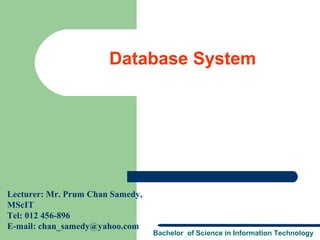a. The Happy Nights motel chain system would be a two-tiered system. The local motel franchise reservation systems would act as clients that connect to a centralized DBMS server located at the central office.
b. The Sticky Wicket Company system would be a three-tiered system. Each branch office acts as a client with its own local DBMS (tier 1). The central Detroit office acts as the middleware tier to connect the branch office DBMS systems. And the centralized inventory database in Detroit acts as the shared database resource (tier 3).




















![Sample of Relational Database
Index
199011913 19959999
19860001 19901913 19911123 19959999
[EMPLOYEE table] colum Index
n
Hire_ Serial_ [DEPARTMENT table]
Emp_Name Salary Dept_No
Year No
Dept_No Department Area
1990 1913 Pich Oudam 180000 5648 Row
5648 Systems P.P
Prum Chan Dara 4327 Personnel KD
1987 0042 200000 4327 2271 General affairs KP
1992 7699 Keo Rithy 190000 2271 0381 Sales KK
. . . . . . . .
. . . . . . . .
. . . . . . .
.
Field
Database system 21](https://image.slidesharecdn.com/chapter01introduction-130219202027-phpapp01/85/Chapter01-introduction-21-320.jpg)






